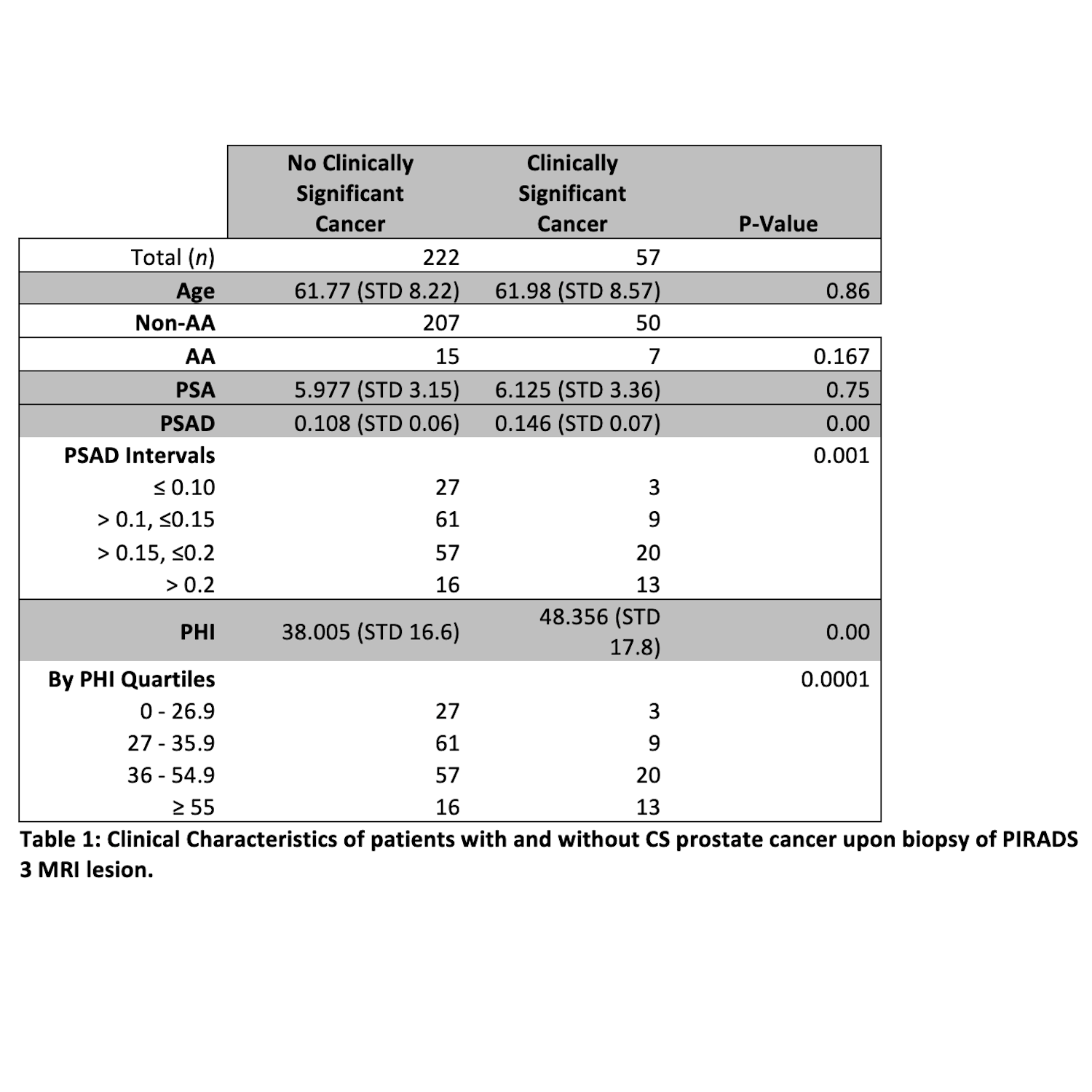Back
Poster, Podium & Video Sessions
Podium
PD57: Prostate Cancer: Detection & Screening VI
PD57-06: Factors Predicting Clinically Significant Prostate Cancer in PIRADS 3 lesions
Monday, May 16, 2022
10:20 AM – 10:30 AM
Location: Room 245
Jasmine Lin*, Mohammad Rashid Siddiqui, Eric Li, Jonathan Aguiar, Brandon Ansbro, Moataz Soliman, Jordan Rich, Johan Alfaro, Mary Kate Keeter, Edward Schaeffer, Ashley Ross, Chicago, IL
- JL
Podium Presenter(s)
Introduction: Though PIRADS 3 lesions are commonly biopsied, the majority are benign. Here, we sought to investigate factors that may help better risk stratify the PIRADS-3 lesions and predict the presence of clinically significant cancer (defined as Gleason Grade Group (GG) = 2).
Methods: We queried the electronic medical record for patients diagnosed with PIRADS 3 lesions beginning in March 2018 with the focus on patients with total PSA 2-20ng/mL. We compared the clinical characteristics such as Age, African American race, PSA, prostate health index (PHI), and PSA Density (PSAD) of patients with and without clinically significant prostate cancer on biopsy (Table 1). Statistics were performed using t-test, chi-squared analysis, and logistical regressions with significance defined as p<0.05.
Results: From March 2018 to present, 3553 men presented to urology at Northwestern Memorial Hospital with suspicion of prostate cancer with 1640 (46%) undergoing prostate MRI. 362 (22%) of men were identified to have the PIRADS 3 lesion as their highest PIRADS lesion. Subsequently, 280 (77%) men underwent prostate needle biopsy with clinically significant cancer detected in 57 (20%) of patients (171 (61%) were negative, while GG1 was found in 51 (18%) of patients). A significant difference was noted between the two groups for PHI (p-value 0.0001) and PSAD (p-value 0.001). Significant predictors of finding clinically significant prostate cancer on biopsy on multivariable analysis included PSAD >0.15 (OR 3.7, 95% CI 0.86-11.60) and PHI = 55(OR 7.5, 95% CI 1.3-41.5).
Conclusions: Consistent with literature, majority of PIRADS 3 lesions are benign in our series, but these lesions can be further risk stratified based on serum biomarker of PHI and PSAD. Roughly 90% of biopsies for men with PIRADS 3 lesions and PHI <36 or PSAD <0.15 failed to demonstrate clinically significant prostate cancer and consideration for biopsy avoidance should be made in these men.
Source of Funding: None

Methods: We queried the electronic medical record for patients diagnosed with PIRADS 3 lesions beginning in March 2018 with the focus on patients with total PSA 2-20ng/mL. We compared the clinical characteristics such as Age, African American race, PSA, prostate health index (PHI), and PSA Density (PSAD) of patients with and without clinically significant prostate cancer on biopsy (Table 1). Statistics were performed using t-test, chi-squared analysis, and logistical regressions with significance defined as p<0.05.
Results: From March 2018 to present, 3553 men presented to urology at Northwestern Memorial Hospital with suspicion of prostate cancer with 1640 (46%) undergoing prostate MRI. 362 (22%) of men were identified to have the PIRADS 3 lesion as their highest PIRADS lesion. Subsequently, 280 (77%) men underwent prostate needle biopsy with clinically significant cancer detected in 57 (20%) of patients (171 (61%) were negative, while GG1 was found in 51 (18%) of patients). A significant difference was noted between the two groups for PHI (p-value 0.0001) and PSAD (p-value 0.001). Significant predictors of finding clinically significant prostate cancer on biopsy on multivariable analysis included PSAD >0.15 (OR 3.7, 95% CI 0.86-11.60) and PHI = 55(OR 7.5, 95% CI 1.3-41.5).
Conclusions: Consistent with literature, majority of PIRADS 3 lesions are benign in our series, but these lesions can be further risk stratified based on serum biomarker of PHI and PSAD. Roughly 90% of biopsies for men with PIRADS 3 lesions and PHI <36 or PSAD <0.15 failed to demonstrate clinically significant prostate cancer and consideration for biopsy avoidance should be made in these men.
Source of Funding: None


.jpg)
.jpg)